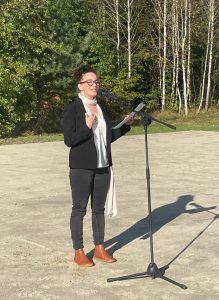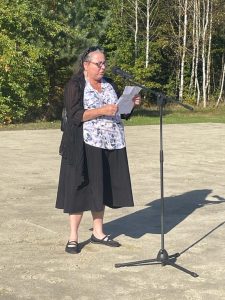Sobibor Uprising 80th Memorial Speeches
Delivered on the site of the uprising at the new memorial and museum at Sobibor, the former Nazi extermination camp in Poland October 14, 2023. The event was organized by Bildungswerk Stanisław Hantz and Stichting Sobibor and hosted by the Sobibor Museum.
 Tagan Engel, Granddaughter of Selma Wijnberg Engel and Chaim Engel
Tagan Engel, Granddaughter of Selma Wijnberg Engel and Chaim Engel
I stand here today to honor the memory of my grandparents Selma (Wijnberg) Engel and Chaim Engel, the memories of every survivor, and every victim who was murdered here including my Grandfather’s brother Meyer Engel and Father Samuel Engel. I am grateful for the opportunity to be in community with each of you as we commemorate this 80th anniversary of the uprising and escape from Sobibor here in the place where it started.
My oma and opa were not originally supposed to be an active part of the uprising, but when one of the prisoners decided he couldn’t do it, my grandfather stepped into the role. He said “it was an instinct, if I didn’t do it, the plan would be over, and everyone would be killed”. Selma brought him a knife from the Sorting barracks, and he went together with another prisoner to kill Beckman, one of the SS guards. If you ever met my grandfather, Chaim, whose name literally means “life” you could not imagine that he could kill someone. He did this to save others, and while he escaped Sobibor, the trauma of that experience and the year he spent at Sobibor never left him.
It is hard to believe that it has been 80 years since the uprising took place. Even though I am two generations removed from the genocide here, the holocaust for me is very present. I was 10 years old when the book Escape from Sobibor was published, and the stories of the survivors and the victims are etched in my being. I used to sit at the kitchen table, drinking tea with my Oma and asking her many questions so that I could try and understand what they witnessed, try and learn about the family lost, the impossible details of the uprising, their escape, hiding, and survival, and I tried to understand how such horrific crimes are possible. It happened long ago, but for me, and for many of us here, it is still so present.
For my grandparents, the truth-telling, about the Holocaust was a responsibility and a duty. They told their story of imprisonment, uprising and escape from Sobibor over and over and over, to any who would listen. They reported the horrors of genocide they witnessed, shared the names of every family member and friend who were murdered, and testified to convict Nazi leaders. For decades, after the publishing of “Escape from Sobibor”, they visited schools and community centers, telling their story, answering questions, and replying to letters. All to retell, to remember, to ensure this horror would never happen again.
They often suffered nightmares and re-lived the trauma of this place after telling their story. This I also witnessed and it made me understand the seriousness of their dedication.
This commitment to truth-telling and documenting the history of the Holocaust is shared by so many survivors, descendants of survivors and Jewish people – as many here can attest to. It is also powerful to witness the deep commitment to this work by many non-jewish historians and even a number of descendants of perpetrators. — It is through the commitments of this broad network of dedicated people that we are here today – NOW with a large memorial, a lot of archaeological information, the memorial lane of remembrance stones, AND very importantly, a museum to document the story of what happened here. After so many decades, I know that my grandparents would feel gratified that this place the Nazi’s tried to hide, now has a museum and a large memorial – so that many more people will know the truth about Sobibor and the uprising.
When I first came to Sobibor in 1996 I was struck by the forest – which was an image long etched in my mind. I pictured Selma and Chaim running for their lives, together with hundreds of others – prisoners fleeing, trying to get away from this horrific place on this day 80 years ago. I saw the forest the Nazi’s planted to cover up Sobibor, after they destroyed the camp to try and hide it from the world. When I arrived here almost 30 years ago there was a single path through the trees with one large sculpture at the end (the one by the museum entrance now), and a mound of ashes surrounded by a low stone wall. It felt like a serious place, but if I did not already know the stories from my Oma and Opa, I would never have come here and I would not have understood the true history of this place. So I too am grateful that there is now a museum to tell the story.
My closeness to the Holocaust and a lifetime of witnessing my Oma and Opa’s commitment to telling the story of Sobibor and fighting for justice, has instilled in me a profound empathy for the suffering of any people or living being and a deep commitment to human rights. Some might think I would be hardened to the world, knowing so intimately the realities of genocide that humans are capable of but for me it has been the opposite. I see the daily and generational suffering of so many peoples and feel a personal obligation to bear witness and take action.
This is my third day at Sobibor this week, and my heart has been aching so deeply that this commemoration is happening at a moment when innocent israeli and palestinian people are experiencing such horrific crimes and violence. It has felt difficult to focus on both of these things at the same time, and also impossible to separate them. I have been asking myself, what is it that I have learned from bearing witness to Sobibor and to my grandparents as survivors that is making me feel so much empathy in this moment – when so many others are beating the drums of war and hate. I think of the dehumanization at the root of the Nazi’s ideology, and this deep commitment I feel to seeing the human-ness of every person to prevent injustices and horrors from happening. I long for and am dedicated to building a world where this empathy for all people and living beings is what motivates all of our societies. That would be true Tikkun Olam – the manifestation of the jewish principle of repairing the world.
There are many things in the story of Sobibor and in this new memorial that give me hope, and take steps towards this repair. I think of Adam and Stefka Novak, the couple in Chelm who risked their lives to hide my grandparents in their barn for 9 months, and saved their lives — which gave me life. I think of the collective action and strength of the prisoners involved in the uprising and escape, something that so few achieved during the Holocaust, although many tried. I am honored by the vastness of this new memorial and museum and do not take it for granted the care being given by each staff member, and the effort and attention being given to this history. I am grateful for the deep relationships, historical documentation and personal memorials created through the efforts of Bildungswerk and Stichting Sobibor. And, I am also grateful for these opportunities to connect with other families of survivors to share our stories, and to support these memorials in being more connected with the survivors and victims of Sobibor. We now have the opportunity to work together to grow and deepen the work of the Sobibor museum and memorial into the future.
Standing in this place, I think about the impossibility of falling in love here. But that is what happened for Selma and Chaim, one from Holland, one from Poland. They were forced to dance together for the entertainment of the Nazis, and they created a bond that lasted for the rest of their lives. When I heard them speak about Sobibor it was so clear that their relationship gave them strength to participate in the uprising, and to survive the escape, 9 months in hiding, and the lifetime of memories they had to live with. My hope is that each of us finds strength in some part of the history of Sobibor, to remember the truth of this history and work together to put an end to genocide and hate in this world.
 Rena Smith-Blatt, daughter of Thomas Toivi Blatt
Rena Smith-Blatt, daughter of Thomas Toivi Blatt
My father Thomas Blatt was a survivor of Sobibor. He was a Polish Jew who lived, who chose to embrace life after death, after nightmares continued, to the end of his days. He woke every day with desire to engage with the world, with history and with the future. He loved Poland, the countryside, food and music. As a child in his village he spoke Yiddish and Polish, as an adult he spoke other languages, as best he could, and spent his lifetime using his voice to assure memory never fades …never becomes diluted but remains with integrity, authentic and whole. This was his living wish, and his dying wish.
So many years ago somehow feels so close. Many descendants of survivors feel close to this time and place, from wherever we call home. Awareness of the strength of this relationship with Sobibor, and the possibility of continued loss in our lifetime, and those to come, may strengthen our resolve and our appreciation for honest reflection, for truth. In my father’s words, “The story must recounted. It is not a truth that would live if people stopped telling it for the truth is so fantastic that without dedicated presentation it could be lost from memory and belief.”
This is the legacy that my father has handed down to me. The knowledge of the atrocious dimensions of humanity, the potential in each of us… I believe that in every moment one should ask “Is this where I should be? Is this what I should be doing? What are the words I should be saying … right now?”
Life is so short and it can be so hard to get from here to our final moments safe, healthy and with our loved ones by our side. We must be guarded against stereotyping generalizing, intolerance, condemnation and self-righteousness. We must use the moments we have consider the significance of our behavior towards one another. We are one, separated by differences that make us unique, and yet unified by the totality of our human experience.

